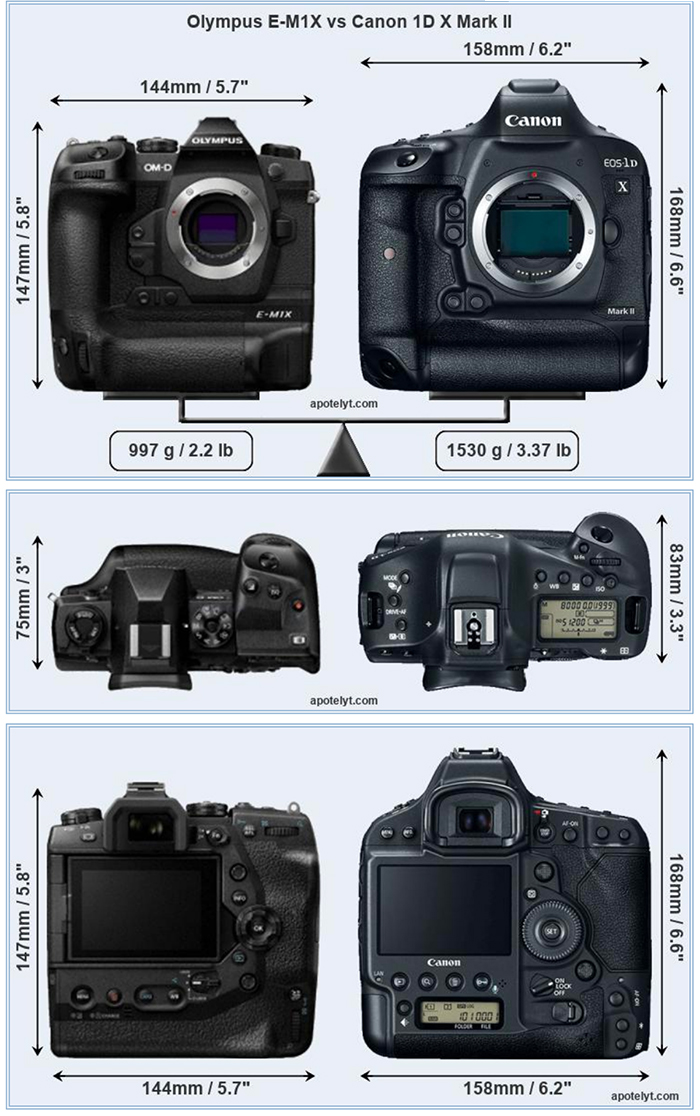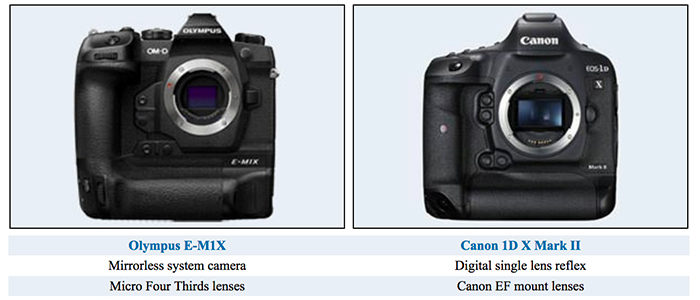Olympus E-M1X vs Canon 1D-X Mark II Size And Specification Comparison
The folks at Apotelyt.com posted an interesting specs and size comparison between the Olympus E-M1X and the Canon 1D-X Mark II.

Next, they summed up the pros and cons of each camera.
Review summary: Olympus E-M1X vs Canon 1D X Mark II
So what is the bottom line? Which of the two cameras – the Olympus E-M1X or the Canon 1D X Mark II – has the upper hand? A synthesis of the relative strong points of each of the models is listed below.
Advantages of the Olympus OM-D E-M1X:
- Maximized detail: Lacks an anti-alias filter to exploit the sensor’s full resolution potential.
- High quality composites: Can combine several shots after pixel-shifting its sensor.
- More framing info: Has an electronic viewfinder that displays shooting data.
- More flexible LCD: Has swivel screen for odd-angle shots in portrait or landscape orientation.
- More selfie-friendly: Has an articulated screen that can be turned to be front-facing.
- Faster burst: Shoots at higher frequency (18 vs 16 flaps/sec) to capture the decisive moment.
- Less disturbing: Has an electronic shutter option for completely silent shooting.
- More compact: Is smaller (144x147mm vs 158x168mm) and thus needs less room in the bag.
- Less heavy: Is lighter (by 533g or 35 percent) and hence easier to carry around.
- Sharper images: Has hand-shake reducing image stabilization built-in.
- More legacy lens friendly: Can take a broad range of non-native lenses via adapters.
- Easier file upload: Has wifi built in for automatic backup or image transfer to the web.
- Easier wireless transfer: Supports Bluetooth for image sharing without cables.
- More affordable: Was introduced into a lower priced category (50 percent cheaper at launch).
- More modern: Reflects 2 years and 11 months of technical progress since the 1DX Mark II launch.
Arguments in favor of the Canon EOS-1D X Mark II:
- Better moiré control: Has an anti-alias filter to avoid artificial patterns to appear in images.
- Better image quality: Features bigger pixels on a larger sensor for higher quality imaging.
- Richer colors: Larger pixels generate images with better, more accurate colors.
- More dynamic range: Capable of capturing a wider spectrum of light and dark details.
- Better low-light sensitivity: Can be used in poorly lit environments and still produce good images.
- Better video: Provides higher movie framerates (4K/60p versus 4K/30p).
- Brighter framing: Features an optical viewfinder for clear, lag-free composition.
- Easier setting verification: Features a control panel on top to check shooting parameters.
- Larger screen: Has a bigger rear LCD (3.2″ vs 3.0″) for image review and settings control.
- More detailed LCD: Has a higher resolution rear screen (1620k vs 1037k dots).
- Longer lasting: Gets more shots (1210 versus 870) out of a single battery charge.
- More heavily discounted: Has been around for much longer (launched in February 2016).

